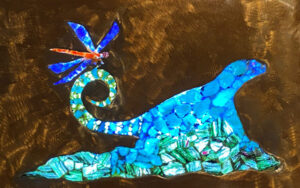I like lizards – no surprise there. In fact, the majority of my family is made up of lizards. But my love for lizards doesn’t stop there. Along with my lizard family members, I decorate my world with decorative lizards. Let’s take a little tour of my abode and let me introduce you to all the lizards that line my walls.
Walls Full of Lizards

Although I do have practical wall lizards, such as the wall lamp that lights up my wall (it’s a great reading light), the majority of my walls are adorned with artwork. I need to be surrounded by creativity. Being surrounded by beauty improves any day.

I rise each morning to this handsome creature. It’s a great photo of one of the species I worked on as a citizen scientist for Cyclura “rock” iguanas. This photo is mounted on aluminum, so it’s lightweight enough to hang easily on the wall.

Even though some of my artwork depicts real lizards, some are creatively colored. This multi-colored horned lizard was created by a Tucson area artist. My brother and his wife gave it to me to hang outside, but I liked it so much that I hung it in my kitchen.

I have some very special artwork on my walls. This piece lights up, showing the beautiful minerals used to create this representation of my character Curtis Curly-tail, who was the protagonist of my first children’s book. This art was created by Zee Haag of Tucson. Instead of a rock iguana, he created for me a “rock” curly-tail lizard.
The Lizards Out Back
My backyard is surrounded by a brick wall. This allows me to keep my desert tortoises outside but contained. Since it’s a wall, I, of course, must festoon it with lizard art. This is one of my favorites. I bought it in a store in Tubac, AZ. This store specializes in artwork from Mexico. I was attracted to this lizard because it was so different from the others that I‘d seen. I haven’t seen one like it since. Despite being exposed to the intense Sonoran Desert sun, it has retained its color. I’m impressed.

I also have metal and other lizards on my walls – so much open space for decorating.
However, despite my enjoyment of all this man-made artwork, there are wall decorations that I like more than all the rest combined. Like this guy, Sceloporus magister, known locally as the desert spiny lizard. This native lizard of the Sonoran and the Chihuahuan Deserts is common around homes here in Tucson. They are bold and willing to interact with the humans who have come into their environment.

Several of these lizards have staked out my patio. They each claim a 4-foot section. Every morning, they come out to greet me. My day starts off well. Sometimes, they do their dominance push-ups, but usually, they just scurry out to say hello. These lizards are as colorful as my man-made artwork. They have blue or violet patches on their bellies and throat, while their tails have green or blue spots. These highlights are on the body colors of yellow, orange, brown, or tan.
These desert spiny lizards are all crucial to the functioning of their environments, sometimes as the prey for other animals. They’re eaten by roadrunners (like in my book Don’t Make Me Fly) and even rattlesnakes (in my book Don’t Make Me Rattle!).
My love of lizards should be pretty obvious since they are featured in many of my books: the Curtis Curly-tail series placed in the Bahamas, the Lime Lizards of Cayman Brac, Andros Iguanas (Cyclura cychlura cychlura), and the Sister Isle Rock Iguanas (Cyclura nubila caymanensis). So even if you don’t want to decorate your home with lizards, you can enjoy reading about them!
